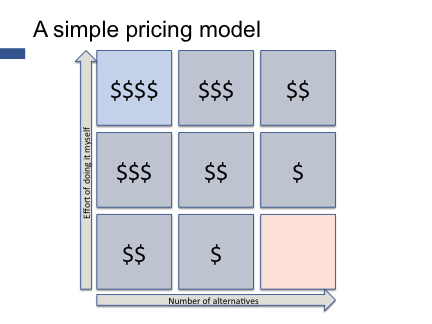Pricing is all about value. “Must have” capabilities are more expensive than “nice to have.” So what’s the value to the client?
A simple way to look at pricing is to use a 3 by 3 matrix (like a tic-tac-toe game). The vertical axis is cost of doing it myself; the horizontal is the number of vendors who offer it. Mark each with low-medium-high. The closer you get to the upper left, the more you can (and should) charge. That is, if it would take a lot for me to learn and there are few vendors who offer it, you can charge me a lot. If it’s fairly easy to learn and I have lots of choices, you won’t be able to charge very much.

For example, I’d put agile method training somewhere in the middle but more towards the lower-right. After all, I have alternatives. I can read books; I can attend training from many vendors; I have access to thousands of certified (or self-proclaimed) Scrum coaches who can come to work with my team.
One way to manipulate this a little is to offer a unique capability that is unavailable elsewhere. A metaphor, a framework, or an approach that is unique to your offering.
Finally, the challenge isn’t whether you can change $5 or $50. The challenge is whether you can charge anything more than $0. With so much free content available, you have to offer something that people are willing to buy. Something people are willing to pay for.




